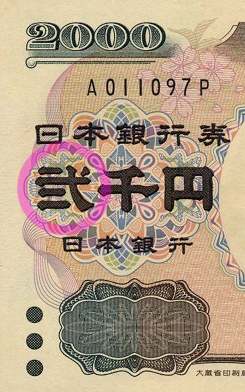
 |
| 2000 yen note with 弍 for "two" |
|---|
The kanji numerals used on bank notes, called daiji (大字), are a special form used in financial documents to prevent cheating. The usual kanji numerals for "one", "two", "three", "ten" and so on are extremely simple, and so it is easy for a forger to alter them, by, for example, adding an extra line to a "one" kanji, 一 in order to make it a "two", 二. The daiji are more complex kanji used to represent the same numerals in order to prevent cheating. This system of numerals is also used in China.
Although it is unlikely that a forger will modify a current-day banknote by altering the kanji numerals, the daiji continue to be used.
Laws such as the Commercial Registration Act (商業登記規則, see link at the end of the page) may mandate the use of these numbers for writing dates and sums of money.
| Value | 1 | 2 | 3 | 4 | 5 | 6 | 7 | 8 | 9 | 10 | 100 | 1,000 | 10,000 |
|---|---|---|---|---|---|---|---|---|---|---|---|---|---|
| Usual kanji | 一 | 二 | 三 | 四 | 五 | 六 | 七 | 八 | 九 | 十 | 百 | 千 | 万 |
| Daiji | 壱 | 弐 | 参 | 肆 | 伍 | 陸 | 漆 | 捌 | 玖 | 拾 | 陌 | 阡 | 萬 |
About the kanji links: Choose the site for kanji links at the kanji.sljfaq.org options page.
See also the FAQ's Western to Kanji and Kanji to Western number converters.
Convert a number in English or arabic numerals into kanji:
Convert a kanji number into English and arabic numerals:
Copyright © 1994-2025 Ben Bullock
If you have questions, corrections, or comments, please contact Ben Bullock or use the discussion forum / Privacy policy

|

|

|

|

|
| Book reviews |
Convert Japanese numbers |
Handwritten kanji recognition |
Stroke order diagrams |
Convert Japanese units |